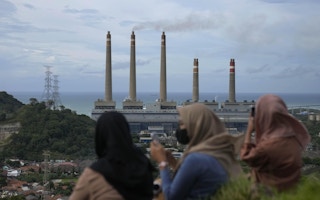On 20 February 2024, the Indonesian Financial Services Authority (OJK) updated its “Indonesian Taxonomy for Sustainable Finance” (TKBI for short in Indonesian). Ideally, such a taxonomy would make it easier to understand how finance is used in ways that are environmentally sustainable. However, the revised TKBI muddies the waters, potentially leading to confusion among investors and financiers. Additionally, it creates difficulties in harmonising with sustainability standards set by other countries and regions.
The TKBI states that the aim is for the standards to be “interoperable with other taxonomies” and “supporting national interests.” However, as it is currently designed, the TKBI complicates the achievement of these objectives, putting at risk the green credentials of Indonesia’s processed metal exports.
On a positive note, the TKBI aligns with the Asean taxonomy, by categorising activities according to four broad Environmental Objectives – climate change mitigation, adaptation, ecosystem and biodiversity protection, and transition to a circular economy. It marks an improvement over the previous Indonesia Green Taxonomy by clearly demarcating activities into three categories: “green,” “transitional,” and a third, “doesn’t meet criteria,” for activities that don’t meet the standards.
Similar to the Singapore taxonomy, the TKBI includes provisions for financing aimed at accelerating the closure of coal-fired power plants (CFPP). This approach is designed to support Indonesia’s efforts to retire coal plants in line with the Just Energy Transition Partnership (JETP) and Energy Transition Mechanism (ETM) plans, despite their limited progress to date.
However, these positives are significantly undermined by the TKBI’s decision to classify financing for new coal-fired power plants as “transitional”.
Not science-based
The TKBI classifies financing for CFPP as a “green” activity if the power plant is captive to a unit involved in the processing or mining of minerals deemed critical to the energy transition. The OJK has sought to justify this inclusion by emphasising the end use of these minerals in advancing the energy transition, for example, in electric vehicles and battery storage systems. Furthermore, it mandates that these power plants must close by 2050 and reduce their emissions by 35 per cent by 2030 compared to the 2021 Indonesian average. Captive power plants established up until 2030 are considered eligible.
Classifying new CFPPs as “transitional” is an approach that is neither standard nor science-based, particularly when juxtaposed with efforts to expedite the closure of existing grid-connected coal plants. Such a move calls into question Indonesia’s commitment to lowering emissions according to its Nationally Determined Contributions under the Paris Agreement.
An Institute for Energy Economics and Financial Analysis (IEEFA) report has highlighted that the combined capacity of the captive power plants, which are either planned or being built, amounts to 21 gigawatts. This represents 52 per cent of Indonesia’s current total power capacity and would result in a 17 per cent increase in the country’s demand for coal.
Additionally, the technical specifications and criteria laid down are either too lax or aspirational. A power plant activity qualifies as transitional if it emits less than 510 grams of carbon dioxide per kilowatt-hour (gm/KWh) over its lifecycle. Under the Asean taxonomy, such levels would be classified as Level 3, which is the category for the highest emissions and the least preferred level. It is important to note that the Asean taxonomy plans to phase out this category by 2030, but the TKBI does not specify an end date for it.
Moreover, the TKBI requires these power plants to reduce their greenhouse gas emissions by at least 35 per cent within their first 10 years of operation compared to the average emissions of CFPPs in Indonesia in 2021. This again translates broadly to the 510gm/KWh level (the International Energy Agency in 2022 estimated an emissions intensity of 750gm/KWh for the electricity sector). In other words, under the TKBI, coal-fired power generation would remain acceptable, even if such plants only manage to meet this minimal standard after a decade, which is beyond the phase-out period set by the Asean taxonomy.
There also appears to be a hope that carbon capture technologies – and the entire transportation and subsurface storage infrastructure chain that needs to accompany them – would develop within these 10 years and allow for a sharp reduction in emissions.
However, IEEFA has presented reasons as to why such hopes are likely to be unfulfilled. The TKBI also appears to implicitly recognise this likelihood by allowing carbon offsets to be used to meet this requirement. This again flies in the face of science-based targets for reducing emissions.
If the 35 per cent reduction target is not met using carbon offsets and if carbon capture and storage technology does not advance as hoped, what is the likely outcome? According to data from the IEA, in 2020, 7 percent of Indonesia’s operational power generation capacity was between 30 to 40 years old. PT Perusahaan Listrik Negara, the Indonesian state-owned utility, also seems to work with the assumption that a power plant has a 30-year operational lifespan.
In this context, it raises the question: would a 10-year-old power plant be decommissioned? If so, who would bear the financial loss: the plant owners, the public, or the financiers?
A recent joint study by McKinsey and the Monetary Authority of Singapore (MAS) has estimated that reducing a CFPP’s operational life by five years can decrease its value by US$70 million per gigawatt, with an additional loss of US$20 million for every subsequent year its economic life is curtailed. This reduction in economic life is also estimated to correspond to a cost increase of 1 US cent per kilowatt-hour.
Taking these estimates into account, a captive power plant that starts operations in 2029 would have its effective economic lifespan reduced to only 21 years if it adheres to the 2050 closure deadline. According to the McKinsey and MAS study, this could result in a financial loss of US$150 million per gigawatt and an increase in power costs by 2 US cents per kilowatt-hour. If the plant were to shut down after just 10 years, the projected financial loss would surge to US$370 million per gigawatt.
Credibility undermined
Indonesia’s efforts to contribute to the green transition and its intention to enhance the value of its mineral resources to benefit its economy are notable. However, the decision to classify new coal-generated power as “green” and to set permissive standards could undermine the credibility of its taxonomy and cast doubt on the government’s climate commitments.
Financiers who are subject to various international standards may find the Indonesian taxonomy’s unique classifications problematic. This divergence could render Indonesia less attractive for investments than other jurisdictions as financiers would need to do extra due diligence on the sustainability of their investments, thereby increasing their costs or possibly leading them to opt out of financing altogether.
Moreover, the end-users of these minerals, especially those in the electric vehicle, battery, and energy storage sectors, are increasingly concerned about the carbon footprint of the materials they use. This concern is becoming a more prominent factor in supply chain management decisions.
The lenient approach to defining what constitutes sustainable activities introduces additional risks to these projects, to the financiers backing them, and eventually, to the Indonesian public, should the state have to absorb some of the financial impact. Despite its aims, the new taxonomy might ultimately not align with national interests in the long run. Instead, it could lead to Indonesia being seen as less appealing for financial investment and may not contribute to the desired reduction in emissions.
Ramnath Iyer is IEEFA’s Research Lead for Sustainable Finance, Asia. IEEFA conducts research and analyses on financial and economic issues related to energy and the environment.











